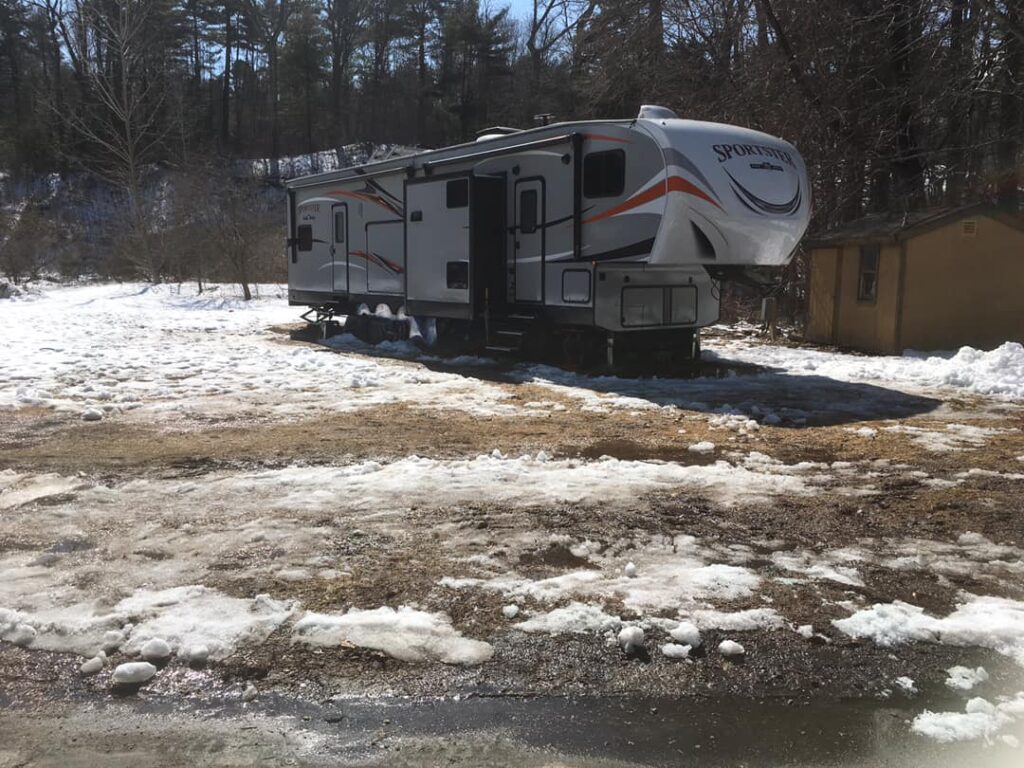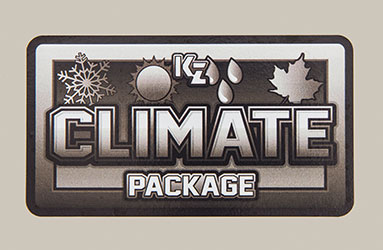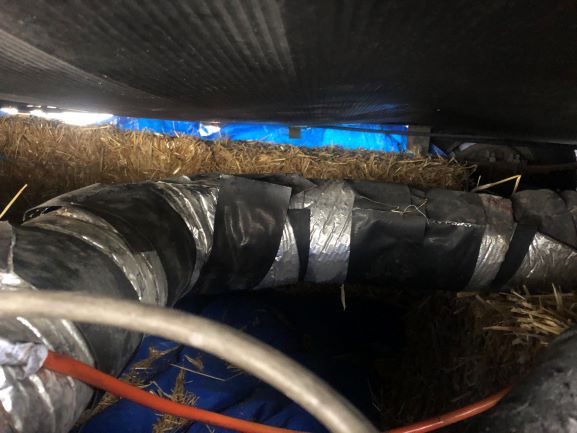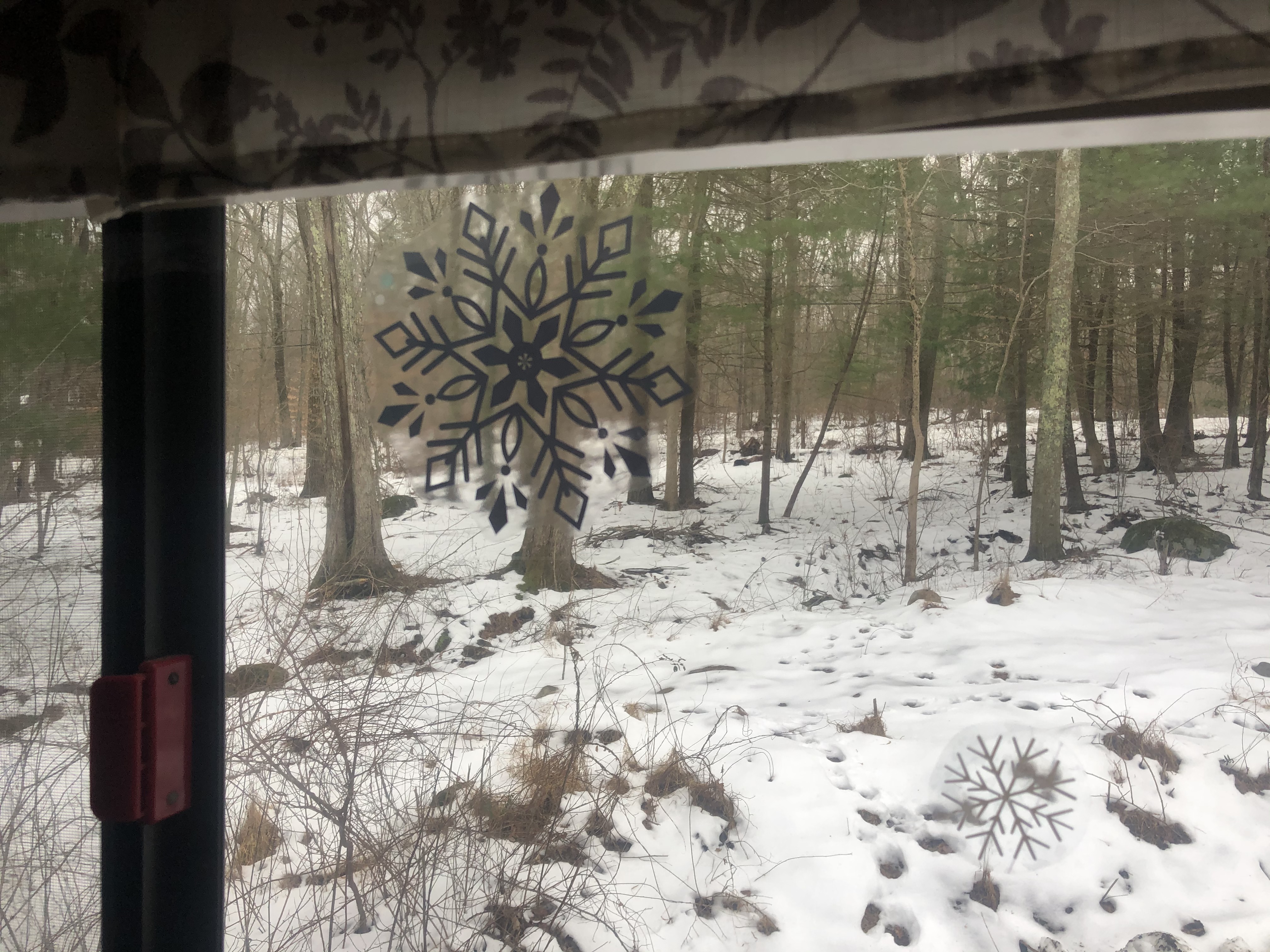
Baby, It’s COLD Outside – Wintering in an RV
Well here it is, winter in New England and yep, we live in a fifth wheel RV.
Common sense would say go somewhere warm, any southern states. We felt a pull to head back to Connecticut where we are originally from. We want to help a friend during a difficult time and at the worst possible time for his business. So…here we are!
This will now be the second time we have done this in Connecticut. So wintering in an RV is nothing new to us.
This is a little idea of the lifestyle while wintering in an RV.
RV Selection
First off make sure you have a four season, arctic, cold weather, etc. package on your RV. Our KZ is a Climate Package.

Keeping Warm
Wintering in an RV is mostly about keeping the underbelly warm.
In an RV, much like anything else, the belly is where everything is. For example, water and waste tanks.
Getting an RV with heated tanks is not a bad idea, for sure. Ours unfortunately does not have a heated underbelly, but we’ve got a few hacks to share that help. And nothing overly invasive or expensive.
The easiest way to keep the underbelly warm is to skirt your RV. You can purchased pre-made, but this option can be pricey and would need installations.
Our first hack was to purchase hay bales for a local nursery and a roll of plastic. Lay the plastic down with enough width and length to go from ground to I-beam/ frame of your RV. Put the bails around the perimeter and wrap up the underbelly.
Be sure to have a layer on the ground under the bales of hay so as to not wick the moisture up from the earth.

We also use heat trace and insulation around any exposed piping. We use the reflectix type insulation as a barrier from the weather.
You especially want to wrap any exposed pipe and the valves so that you don’t end up with a “poopsicle”.
Cut strips of the reflectix roughly 2”-3” wide and after wrapping the heat trace wire sufficiently as per instructions, wrap the insulation around the pipe and valves then tape with a good weatherproof tape. (Either HVAC tape like reflectix tape or like we’ve used and traveled 20,000 mile with gorilla tape). The gorilla tape has multiple functions while living in an RV. Good thing to have around.
Water Needs
It’s also important to keep any fresh water lines from being exposed. You can purchase heated water hoses but as you can see they are expensive.
Just tape the heat trace to the hose and use a GOOD pipe insulation. Preferably at least ½” wall thickness.
The open cell foam type you can get cheap will not work as well as the closed cell Armaflex that has been used in the HVAC industry for decades. Yep, it is really expensive but this insulation will need to be used no matter what kind of hose you choose. Heated or not heated.
You will want to measure the outside diameter of your hose, including the heat trace, to get the appropriate inside diameter of the insulation.
Also note: we recommend split so you can easily fit around the hose and not have to feed the entire length of hose through the insulation. Not fun, so feel free to learn from our mistakes!
Water Availability
This 2020 season we opted to just keep our fresh water tank full and have standby water in a fresh water jug in case of emergencies.
Keeping the fresh water tank full and the belly of Delta Dawn (our KZ fifth wheel) warm using the methods mentioned earlier, as well as running our gas furnace especially during the extreme cold weather, helped keep us warm as well as our water flowing.
Energy Conservation
Next is the windows. Windows in an RV are not exactly the most effective in the energy conservation world. With a little hack they can be though.
If you do not mind being cooped up and feel like your in a cave, you can cut the refectix insulation mentioned earlier and this will work great. Just be sure to leave a little air gap to prevent moisture buildup.
We personally did not like that option so we opted for a heat shrink window kit. This gives us (and the cats) full visibility to the world around us and keep out some of the cold. We could definitely tell a major difference using the film on the windows.


The End Results?
Although living in the colder climates while in an RV is not a perfect world, it can doable and comfortable with a few simple precautions. These are a few of our ideas based on research of the subject and good old fashioned Yankee ingenuity.
Share this:
Related
2 thoughts on “Baby, It’s COLD Outside – Wintering in an RV”
Comments are closed.
Thank you for the tips about winter protection for my travel trailer ,as you know we recently moved to North Carolina and just bought a new 26′ travel trailer ,my concern is winterizing while still going out once a month ,the temps still can drop to 20 degrees at night around here and draining the hot water tank and blowing out the lines can be a pain ,any ideas on protection in between traveling ?
Hey Steve hope all is well is well in North Carolina and thank you for the comment. Great question. The fact that we never shut ours down will require me to think about this. My first thought is to keep the belly of the RV warm as I mentioned in the post. Keeping the heat on at minimal temps within the ‘dwelling on wheels’ would be great as well. Maintaining the heater on either fuel, electric or propane will help and not break the bank. This will all be dependent on how long between trips. If there will be a while between trips, I’d suggest blowing it out and winterize but if only a couple of weeks of down time just leaving your home on wheels ready and willing would be my thoughts.
Thanks again,
Sean